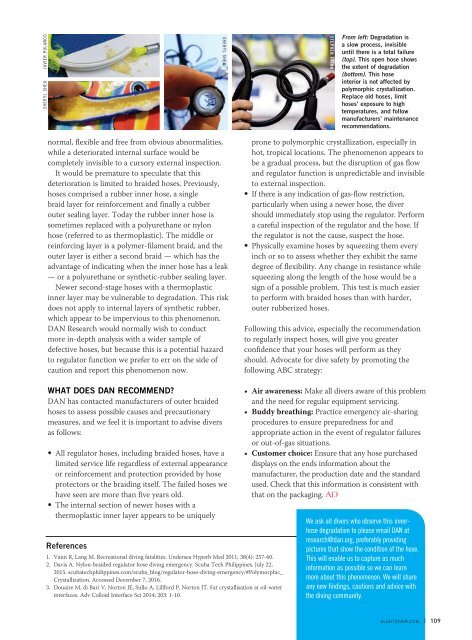AD 2017 Q1
Alert Diver is the dive industry’s leading publication. Featuring DAN’s core content of dive safety, research, education and medical information, each issue is a must-read reference, archived and shared by passionate scuba enthusiasts. In addition, Alert Diver showcases fascinating dive destinations and marine environmental topics through images from the world’s greatest underwater photographers and stories from the most experienced and eloquent dive journalists in the business.
Alert Diver is the dive industry’s leading publication. Featuring DAN’s core content of dive safety, research, education and medical information, each issue is a must-read reference, archived and shared by passionate scuba enthusiasts. In addition, Alert Diver showcases fascinating dive destinations and marine environmental topics through images from the world’s greatest underwater photographers and stories from the most experienced and eloquent dive journalists in the business.
You also want an ePaper? Increase the reach of your titles
YUMPU automatically turns print PDFs into web optimized ePapers that Google loves.
JAVIER POLANCO<br />
SHERYL SHEA<br />
SHERYL SHEA<br />
STEPHEN FRINK<br />
From left: Degradation is<br />
a slow process, invisible<br />
until there is a total failure<br />
(top). This open hose shows<br />
the extent of degradation<br />
(bottom). This hose<br />
interior is not affected by<br />
polymorphic crystallization.<br />
Replace old hoses, limit<br />
hoses’ exposure to high<br />
temperatures, and follow<br />
manufacturers’ maintenance<br />
recommendations.<br />
normal, flexible and free from obvious abnormalities,<br />
while a deteriorated internal surface would be<br />
completely invisible to a cursory external inspection.<br />
It would be premature to speculate that this<br />
deterioration is limited to braided hoses. Previously,<br />
hoses comprised a rubber inner hose, a single<br />
braid layer for reinforcement and finally a rubber<br />
outer sealing layer. Today the rubber inner hose is<br />
sometimes replaced with a polyurethane or nylon<br />
hose (referred to as thermoplastic). The middle or<br />
reinforcing layer is a polymer-filament braid, and the<br />
outer layer is either a second braid — which has the<br />
advantage of indicating when the inner hose has a leak<br />
— or a polyurethane or synthetic-rubber sealing layer.<br />
Newer second-stage hoses with a thermoplastic<br />
inner layer may be vulnerable to degradation. This risk<br />
does not apply to internal layers of synthetic rubber,<br />
which appear to be impervious to this phenomenon.<br />
DAN Research would normally wish to conduct<br />
more in-depth analysis with a wider sample of<br />
defective hoses, but because this is a potential hazard<br />
to regulator function we prefer to err on the side of<br />
caution and report this phenomenon now.<br />
prone to polymorphic crystallization, especially in<br />
hot, tropical locations. The phenomenon appears to<br />
be a gradual process, but the disruption of gas flow<br />
and regulator function is unpredictable and invisible<br />
to external inspection.<br />
• If there is any indication of gas-flow restriction,<br />
particularly when using a newer hose, the diver<br />
should immediately stop using the regulator. Perform<br />
a careful inspection of the regulator and the hose. If<br />
the regulator is not the cause, suspect the hose.<br />
• Physically examine hoses by squeezing them every<br />
inch or so to assess whether they exhibit the same<br />
degree of flexibility. Any change in resistance while<br />
squeezing along the length of the hose would be a<br />
sign of a possible problem. This test is much easier<br />
to perform with braided hoses than with harder,<br />
outer rubberized hoses.<br />
Following this advice, especially the recommendation<br />
to regularly inspect hoses, will give you greater<br />
confidence that your hoses will perform as they<br />
should. Advocate for dive safety by promoting the<br />
following ABC strategy:<br />
WHAT DOES DAN RECOMMEND?<br />
DAN has contacted manufacturers of outer braided<br />
hoses to assess possible causes and precautionary<br />
measures, and we feel it is important to advise divers<br />
as follows:<br />
• All regulator hoses, including braided hoses, have a<br />
limited service life regardless of external appearance<br />
or reinforcement and protection provided by hose<br />
protectors or the braiding itself. The failed hoses we<br />
have seen are more than five years old.<br />
• The internal section of newer hoses with a<br />
thermoplastic inner layer appears to be uniquely<br />
References<br />
1. Vann R, Lang M. Recreational diving fatalities. Undersea Hyperb Med 2011; 38(4): 257-60.<br />
2. Davis A. Nylon-braided regulator hose diving emergency. Scuba Tech Philippines. July 22,<br />
2015. scubatechphilippines.com/scuba_blog/regulator-hose-diving-emergency/#Polymorphic_<br />
Crystallization. Accessed December 7, 2016.<br />
3. Douaire M, di Bari V, Norton JE, Sullo A, Lillford P, Norton IT. Fat crystallisation at oil-water<br />
interfaces. Adv Colloid Interface Sci 2014; 203: 1-10.<br />
• Air awareness: Make all divers aware of this problem<br />
and the need for regular equipment servicing.<br />
• Buddy breathing: Practice emergency air-sharing<br />
procedures to ensure preparedness for and<br />
appropriate action in the event of regulator failures<br />
or out-of-gas situations.<br />
• Customer choice: Ensure that any hose purchased<br />
displays on the ends information about the<br />
manufacturer, the production date and the standard<br />
used. Check that this information is consistent with<br />
that on the packaging. <strong>AD</strong><br />
We ask all divers who observe this innerhose<br />
degradation to please email DAN at<br />
research@dan.org, preferably providing<br />
pictures that show the condition of the hose.<br />
This will enable us to capture as much<br />
information as possible so we can learn<br />
more about this phenomenon. We will share<br />
any new findings, cautions and advice with<br />
the diving community.<br />
ALERTDIVER.COM | 109









